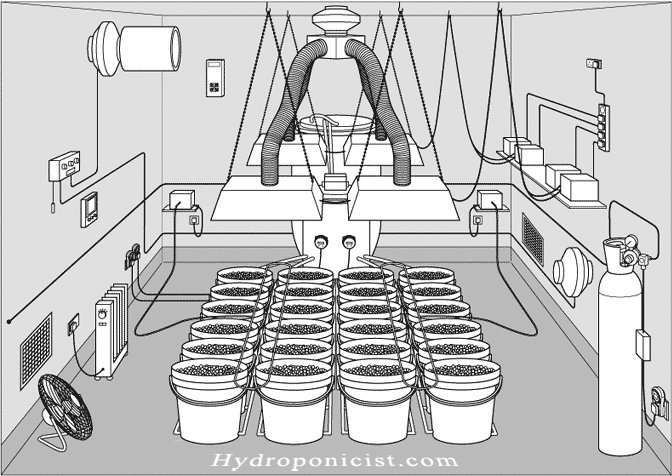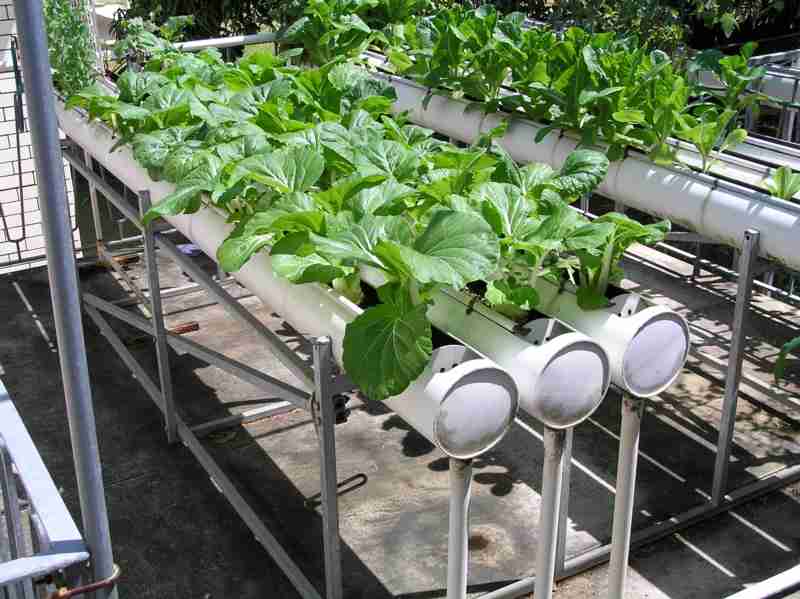Aeroponics

Aeroponics is a system where roots are continuously or discontinuously kept in an environment saturated with fine drops (a mist or aerosol) of nutrient solution. The method requires no substrate and entails growing plants with their roots suspended in a deep air or growth chamber with the roots periodically wetted with a fine mist of atomized nutrients. Excellent aeration is the main advantage of aeroponics.
Aeroponic techniques have proved to be commercially successful for propagation, seed germination, seed potato production, tomato production, leaf crops and micro-greens. Since Richard Stoner, inventor and entrepreneur, first commercialized aeroponic technology in 1983 aeroponics has been implemented as an alternative to water intensive hydroponic systems worldwide The limitation of hydroponics is the fact that 1 kg of water can only hold 8 mg of air, no matter if aerators are utilized or not.
Another distinct advantage of aeroponics over hydroponics is that any species of plants can be grown in a true aeroponic system because the micro environment of an aeroponic can be finely controlled. The limitation of hydroponics is that only certain species of plants can survive for so long in water before they become water logged. The advantage of aeroponics is due to the fact that suspended aeroponic plants receive 100% of the available oxygen and CO2 to the roots zone, stems and leavesthus accelerating biomass growth and reducing rooting times. NASA research has shown that aeroponically grown plants have an 80% increase in dry weight biomass (essential minerals) compared to hydroponically grown plants. Aeroponics used 65% less water than hydroponics. NASA also concluded that aeroponically grown plants requires ¼ the nutrient input compared to hydroponics. Unlike hydroponically grown plants, aeroponically plants will not suffer transplant shock when transplanted to soil. Unlike hydroponics, aeroponics also offers growers the ability to reduce the spread of disease and pathogens Aeroponics is also widely used in laboratory studies of plant physiology and plant pathology. Aeroponic techniques have been given special attention from NASA since a mist is easier to handle than a liquid in a zero gravity environment.
Passive subirrigation>
Passive subirrigation, also known as passive hydroponics or semi-hydroponics, is a method where plants are grown in an inertporous medium that transports water and fertilizer to the roots by capillary action from a separate reservoir as necessary, reducing labor and providing a constant supply of water to the roots. In the simplest method, the pot sits in a shallow solution of fertilizer and water or on a capillary mat saturated with nutrient solution. The various hydroponic media available, such as expanded clay and coconut husk, contain more air space than more traditional potting mixes, delivering increased oxygen to the roots, which is important in epiphytic plants such as orchids and bromeliads, whose roots are exposed to the air in nature. Additional advantages of passive hydroponics are the reduction of root rot and the additional ambient humidity provided through evaporation.
Ebb and flow / Flood and drain subirrigation>
In its simplest form, there is a tray above a reservoir of nutrient solution. The tray is either filled with growing medium (clay granules being the most common) and planted directly, or pots of medium stand in the tray. At regular intervals, a simple timer causes a pump to fill the upper tray with nutrient solution, after which the solution drains back down into the reservoir. This keeps the medium regularly flushed with nutrients and air. Once the upper tray fills past the drain stop it begins recirculating the water until the pump is turned off and the water in the upper tray drains back into the reservoir.
Top irrigation>
In Top irrigation, nutrient solution is periodically applied to the medium surface. This may be done manually once per day in large containers of some media, such as sand. Usually, it is automated with a pump, timer and drip irrigation tubing to deliver nutrient solution as frequently as 5 to 10 minutes every hour.
Deep water culture>
The hydroponics method of plant production by means of suspending the plant roots in a solution of nutrient rich, oxygenated water. Traditional methods favor the use of plastic buckets and large containers with the plant contained in a net pot suspended from the centre of the lid and the roots suspended in the nutrient solution.
Expanded clay>
Baked clay pellets, also known under the trademarks 'Hydroton' or LECA (light expanded clay aggregate), are suitable for hydroponic systems in which all nutrients are carefully controlled in water solution. The clay pellets are inert, pH neutral and do not contain any nutrient value.
The clay is formed into round pellets and fired in rotary kilns at 1200 °C. This causes the clay to expand, like popcorn, and become porous. It is light in weight, and does not compact over time. Shape of individual pellet can be irregular or uniform depending on brand and manufacturing process. The manufacturers consider expanded clay to be an ecologically sustainable and re-usable growing medium because of its ability to be cleaned and sterilized, typically by washing in solutions of white vinegar, chlorinebleach or hydrogen peroxide (H2O2), and rinsing completely.
A less popular view is that clay pebbles are best not re-used even when they are cleaned, due to root growth which may enter the medium. Breaking open a clay pebble after a crop has been grown will reveal this growth.
Rock wool>
Rock wool (mineral wool) is probably the most widely used medium in hydroponics. Rock Wool is an inert substrate for both 'free drainage' and recirculating systems. It is produced by aerosolization of molten mineral compounds, resulting in a fibrous medium accessible to capillary action that is not degraded by microbiological activity.
Coir</>
Coco Peat, also known as coir or coco, is the leftover material after the fibres have been removed from the outermost shell (bolster) of the coconut. Coir is a 100% natural grow and flowering medium.
Perlite>
Perlite is a volcanic rock that has been superheated into very lightweight expanded glass pebbles. It is used loose or in plastic sleeves immersed in the water. It is also used in potting soil mixes to decrease soil density. Perlite has similar properties and uses to vermiculite but generally holds more air and less water. If not contained, it can float if flood and drain feeding is used. It is a fusion of granite, obsidian, pumice and basalt. This volcanic rock is naturally fused at high temperatures undergoing what is called "Fusionic Metamorphosis".
Vermiculite>
Like perlite, vermiculite is another mineral that has been superheated until it has expanded into light pebbles. Vermiculite holds more water than perlite and has a natural "wicking" property that can draw water and nutrients in a passive hydroponic system. If too much water and not enough air surrounds the plants roots, it's possible to gradually lower the medium's water-retention capability by mixing in increasing quantities of perlite.
Sand>
Sand is cheap and easily available. However, it is heavy, it does not always drain well, and it must be sterilized between use.
Gravel>
The same type that is used in aquariums, though any small gravel can be used, provided it is washed first. Indeed, plants growing in a typical traditional gravel filter bed, with water circulated using electric powerhead pumps, are in effect being grown using gravel hydroponics. Gravel is inexpensive, easy to keep clean, drains well and won't become waterlogged. However, it is also heavy, and if the system doesn't provide continuous water, the plant roots may dry out.
Brick shards>
Brick shards have similar properties to gravel. They have the added disadvantages of possibly altering the pH and requiring extra cleaning before reuse.
Polystyrene packing peanuts>
Polystyrene packing peanuts are inexpensive, readily available, and have excellent drainage. However, they can be too lightweight for some uses. They are mainly used in closed tube systems. Note that polystyrene peanuts must be used; biodegradable packing peanuts will decompose into a sludge. Plants may absorb styrene and pass it to their consumers; this is a possible health risk.
Styrofoam</SPAN>
Similar to polystyrene packing, plants may absorb PVC which is a health risk when consumed.
Wood fibre>
Wood fibre, produced from steam friction of wood, is a very efficient organic substrate for hydroponics. It has the advantage that it keeps its stucture for a very long time.
Nutrient solutions>
Plant nutrients are dissolved in the water used in hydroponics and are mostly in inorganic and ionic form. Primary among the dissolved cations (positively-charged ions) are Ca2+ (calcium), Mg2+ (magnesium), and K+ (potassium); the major nutrient anions in nutrient solutions are NO3− (nitrate), SO42− (sulfate), and H2PO4− (dihydrogen phosphate).
Numerous 'recipes' for hydroponic solutions are available. Many use different combinations of chemicals to reach similar total final compositions. Commonly-used chemicals for the macronutrients include potassium nitrate, calcium nitrate, potassium phosphate, and magnesium sulfate. Various micronutrients are typically added to hydroponic solutions to supply essential elements; among them are Fe (iron), Mn (manganese), Cu (copper), Zn (zinc), B (boron), Cl (chlorine), and Ni (nickel). Chelating agents are sometimes used to keep Fe soluble. Many variations of the nutrient solutions used by Arnon and Hoagland (see above) have been styled 'modified Hoagland solutions' and are widely used. Variation of different mixes throughout the plant life cycle, further optimizes its nutritional value.[10]
Plants will change the composition of the nutrient solutions upon contact by depleting specific nutrients more rapidly than others, removing water from the solution, and altering the pH by excretion of either acidity or alkalinity. Care is required not to allow salt concentrations to become too high, nutrients to become too depleted, or pH to wander far from the desired value.











